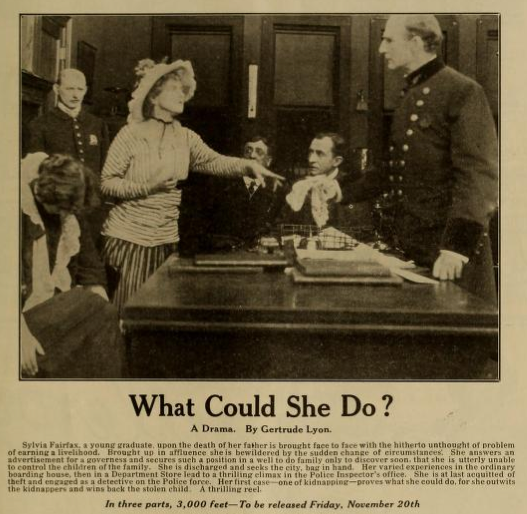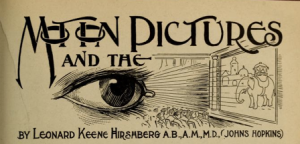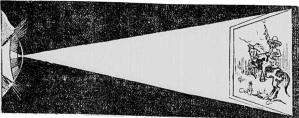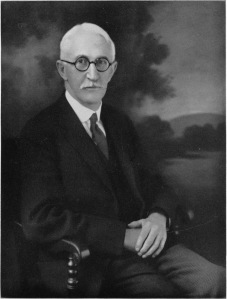The Girl of the Golden West (Cecil B. Demille)
100 years ago today, the first film adaptation of David Belasco’s The Girl of the Golden West was playing at the Apollo Theater in Tacoma Washington.
What Could She Do? (Edison)
Full Page Ad for The Devils Eye

Full page ad for The Devil’s Eye from The Moving Picture World, Vol. 20 (June 1914) p. 1785
100 years ago today, The Devil’s Eye played at the Victoria Theater in Harrisburg PA
Link to IMDB page: http://www.imdb.com/title/tt0461389/
Dominion General Film Corporation, Limited
100 years ago today, Canadian Film Company DOMINION GENERAL FILM CORPORATION was incorporated. It was a collaboration between two New Yorkers, Leslie Carter Harris and Rudolph Bergman, and three Québécois, John William Peachy, Maurice Marcelot, and Marie Fabiola Caissee.
The company’s incorporation papers were published in the August 1, 1914 edition of The Canada Gazette. It is interesting to note that the company’s patent covered not only the making of motion pictures, but also the construction and operation of “boats and launches … and any and all kinds of devices and apparatus designed for recreation and amusement.” The article in The Moving Picture World makes no reference to this aspect of the company’s stated endeavors. Further investigation might reveal that the founders of Dominion General Film Corporation were thinking about movies not simply as stand-alone commodities, but rather, as visual experiences to be incorporated within amusement parks, into the repertoire of traveling vaudeville shows, and apparently, on boats.
SOURCES:
THE CANADA GAZETTE online, courtesy of the Library and Archives of Canada. www.collectionscanada.gc.ca
THE MOVING PICTURE WORLD online, courtesy of the Media History Digital Library and the Internet Archive. To search historical film periodicals check out Lantern at http://lantern.mediahist.org/
Over Niagara Falls
100 years ago today, Over Niagara Falls was playing at the Palmetto Theatre in Anderson, South Carolina.

Palmetto Theatre Advertisement for Over Niagara Falls in The Anderson (South Carolina) Daily Intelligencer. 18 June 1914, 8. Image courtesy of The Library of Congress, Chronicling America: http://chroniclingamerica.loc.gov/lccn/sn93067669/1914-06-18/ed-1/seq-8/
The text on the right of the ad reads: WITNESS:1 The wreck of a big automobile by a fast running freight train.

Advertisement for Over Niagara Falls in Motion Picture News, 3 January 1919, 55, Detail 3. From the Media History Digital Library. Link to page in context: https://archive.org/stream/motionpicturenew82unse#page/55/mode/1up/
2. The trip over the falls in a barrel which contains the heroine
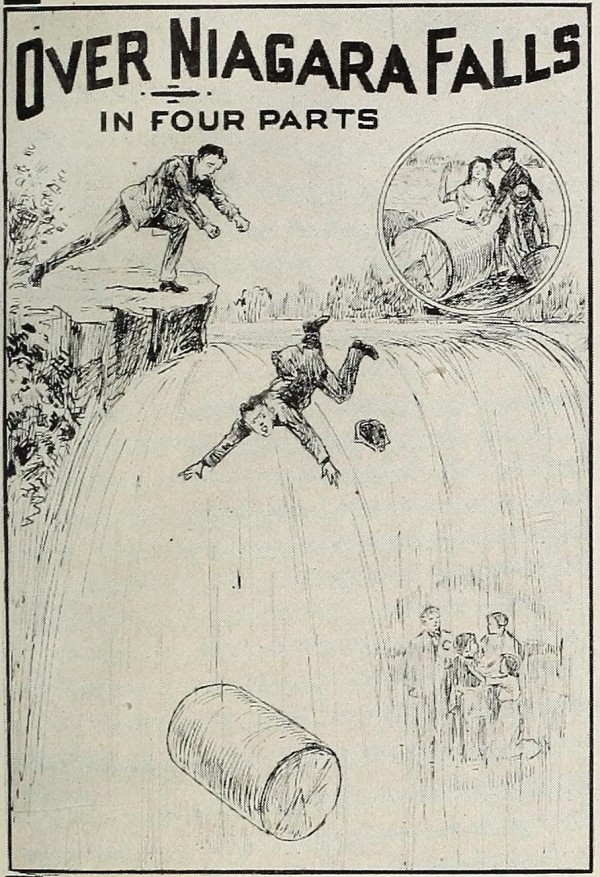
Advertisement for Over Niagara Falls in Motion Picture News, 3 January 1919, 55. Detail 1 From the Media History Digital Library. Link to page in context: https://archive.org/stream/motionpicturenew82unse#page/55/mode/1up/
3.The plunge of the villain headforemost in the falls and his death in the whirlpool below.

Advertisement for Over Niagara Falls in Motion Picture News, 3 January 1919, 55, detail 2. From the Media History Digital Library. Link to page in context: https://archive.org/stream/motionpicturenew82unse#page/55/mode/1up/
IMDB page for Over Niagara Falls: http://www.imdb.com/title/tt0004447/
According to the Progressive Silent Film List, Over Niagara Falls is lost. http://www.silentera.com/PSFL/data/O/OverNiagaraFalls1914.html
For more information about the Palmetto Theatre, check out http://cinematreasures.org/theaters/14860
For more information about the Media History Digital Library, which enabled me to find these images, check out http://mediahistoryproject.org/
Neptune’s Daughter, dir. Herbert Brenon
100 years ago today, Neptune’s Daughter premiered at the Globe Theater in New York City. It was the first moving picture to get a substantial screening in this theater previously reserved for “legitimate” productions. The fantasy feature starring Australian swimmer and vaudeville star Annette Kellerman enjoyed great success, breaking a record with its 24-week run at the Fine Arts Theater in Chicago and “delighting nobility” at Shaftesbury Pavilion in England.
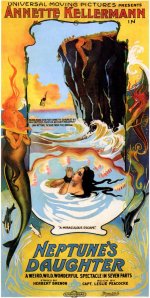
Neptune’s Daughter Poster
Source: http://www.inherited-values.com/2010/01/collecting-the-history-of-silent-film/
The film, featuring a nearly-nude Kellerman, stirred some controversy in Malden MA, when it played at the Mystic Theater.
According to this article in the Moving Picture World, the Mystic theater’s proprietor invited the city’s prominent citizens to view the film and weigh in on its merits. Mrs. George M. Chisholm was not pleased with what she saw: “The high dive in which Miss Kellerman is in fleshlings [sic], by swimming to cover when people approach, gives the impression that she is nude, is suggestive and not a good thing for high school boys and girls to see” She also objected to the part of the film in which “the mermaid is turned to an earth maiden and comes out of the woods seemingly clothed only in her flowing hair.”
Judge Bruce of the Malden District Court objected to Mrs. Chisolsm’s objections stating that “There is such a thing as being so pure that you are impure. Not only that, but Miss Kellerman’s figure is very beautiful–in fact, beautiful enough to lead other women to envy and jealousy. A moral is taught in that love and purity triumph throughout the picture. The entire film is beautiful and not at all suggestive to a wholesome mind.”
I have no idea what he’s talking about with all this “being so pure that you are impure” business. I imagine that his wife, who was in attendance with him at the screening, gave him a good smack upside the head when they got home.
According to Mary Ann Cade, this film is held in two archives: http://www.silentsaregolden.com/articles/lostfilmsarticle.html
Excerpts from the film are included as extras in Grapevine Video’s DVD of a later Kellerman film, Venus of the South Seas (1924)
How Motion Picture Make you See Better
Everybody goes to the “movies.” Not only are moving pictures theaters cheap, but the performances you see are as good if not better than you seen in the two-dollar houses. You have the pleasure, the music, the comfort, the entertainment and the instruction in a moving picture theatre to a greater certainty than in many so-called ‘legitimate houses,’ and at far less expense.
The other day I saw James K. Hackett and a Frohman company [of actors?] in a four-reel photo-play for five cents.6-sheet poster for The Prisoner of Zenda; Image Source: http://www.postermountain.com/form/posters/formatted/7001
You may see “Les miserables,” Hamlet,” and a thousand other instructive plays intermingled with zoology, trips to foreign lands, humor and the like, in a motion picture playhouse. These motion picture plays are better acted and in every way more satisfying than a great many theatrical productions for which you would have to pay one or two dollars a seat.
What harm is there then, in visiting the “movies”? Are the eyes injured: Is the health of the patrons destroyed? Are the morals of the young corrupted by them?Illustration from the original article: Leonard Keene Hirshberg, “How Motion Pictures Make You See Better” The times dispatch: Richmond, VA, March 15, 1914, Chronicling America: Historic American Newspapers. Lib. of Congress.
The answer to all of these quires is an emphatic, No! Just as the old-age playhouse gradually eliminated all taint of vice from its performances; just as the editors of magazines have come to understand that the reading public does not relish even a small dose of the wicked, so the photoplay producers have learned that their public will have none of the suggestive, the vicious, or the unpleasant.
Militant prudes and belligerent moralists who read vice into tea-drinking, and whose voices are for war against any pleasures whatsoever; who spit forth their crusading indignation against moderate tobacco smoking, Sunday walks, the stately minuet and the graceful Boston waltz, have already recognized the trend to censor or censure it. But certain amateur physiologists and opticians continue to attack this form of entertainment and instruction. In their ignorance they declare that defective vision, styes, granulated eyelids, eyestrain, pinkeye, inflamed lids, crossed eyes and other troubles may each and all develop from attendance at the moving pictures.Dr. Herbert Harlan, photo source: http://www.fsmb.org/centennial/early-fsmb-leadership.html
Dr. Herbert Harlan, Surgeon-General of Maryland, perhaps the best ophthalmologist in the South, and the envoy sent by the Government to study the dreadful eye malady trachoma in the wilds of West Virginia says these charges are nonsense. Dr. Harlan, with whom I feel upon this matter in hearty concord, asserts that the hour or so spent each day in watching the moving picture shows can result in no harm to the eyes. In fact, I go even farther and assert that two hours a day i the dark auditorium of a picture playhouse, watching the moving films, is actually a valuable tonic to tired eyes.
Knight Dunlop. Source: http://digitool.library.colostate.edu/
Experiments by Professor Knight Dunlap in the psychological laboratories of Johns Hopkins University have show that even the slight flicker which occasionally appear on motion pictures tones up the eyesight and makes it more acute.
It is unwise, perhaps, for some persons to sew, read or attempt to use their eyes at close range on a moving train, motor car, fast boat, or airplane. The flickering lights and shadows from this vibration are liable to do harm to your retina. Why? Because the peephole, muscles and lens for your eyes must be constantly changing focus.
This is not the case with moving pictures. At the ‘movies’ the spectator sits from twelve to several hundred feet away from the screen upon which the motion photographs are thrown.
At that distance the focus of the eye changes but little, not matter how much flicker there may be. In fact, a little flicker is beneficial, because it keeps the eye muscles from becoming sluggish, worn out and unadaptable to change.[…] Undoubtedly children, and adults as well, have become more observant and better educated in many respects since motion pictures have acquired such a vogue. Recent psychological tests made upon children immediately after leaving a moving picture exhibition prove that they distinguish colors more acutely, recognize form and shape more sharply, and remember figures, size and other visual difference better than they did before they went in to see the pictures. They surpassed in all the tests children who had not visited the ‘movies,’ but who were, nevertheless subjected to the same kind of excitement by witnessing a melodrama performed by actual flesh-and-blood actors.
[…] In a large American city, where there are several hundred moving picture theaters and half as many eye specialists, it was soon made clear that not one true example of eye-twitching could be blamed upon motion pictures. Many of these chases were due only to the need of eye-glasses.
[…] Finally, it may be said that if the motion picture habit has nothing else than remind people of their eye troubles and send them post-haste to an oculist, it has accomplished an incalculable among of good for the human eye.
– Leonard Keene Hirshberg, “How Motion Pictures Make You See Better” The times dispatch: Richmond, VA, March 15, 1914,
See also, a reprint (or the original?) of this article published in The Motion Picture Story Magazine, which is accessible here: http://archive.org/stream/motionpicturesto07moti#page/n487/mode/2up

